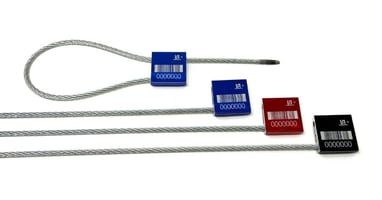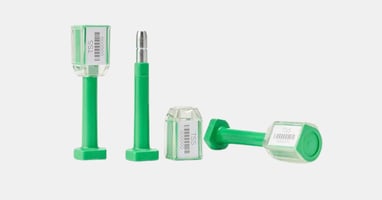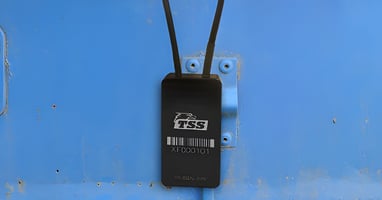Security seals play an instrumental role in ensuring the integrity of goods during transit. From...
A Look at ISO and C-TPAT Compliance Standards for Bolt Seals

Supply chain security is a growing concern in today’s interconnected global trade network. Managing risks and ensuring the integrity of shipments has become crucial for businesses—even more so as they strive to meet international standards and align with regulatory compliance. One important component in this complex puzzle is bolt seals.
If you’re not familiar with ISO and C-TPAT compliance standards for bolt seals, learning about them can improve your security, efficiency, and business operations. Explore bolt seals' role in compliance standards and some actionable tips to ensure your organization meets these industry benchmarks.
What Are Bolt Seals and Why Do They Matter?
Bolt seals are tamper-evident security seals primarily used in the shipment and transportation of goods. Composed of durable materials like coated carbon steel, they act as both a visual and physical deterrent to unauthorized access during transit. Each bolt seal comes with a unique identification number, ensuring shipments can be tracked and authenticated at every touchpoint.
These seals are frequently used across industries such as logistics, manufacturing, and retail due to their ability to prevent theft, smuggling, and the illicit tampering of goods. Without bolt seals, the global supply chain would face severe vulnerabilities, putting businesses and consumers at risk.
The Role of Compliance Standards in Global Supply Chains
Compliance standards are essential for strengthening the integrity of global supply chains. These standards provide businesses with guidelines for meeting industry regulations. This includes enhancing cross-border trade security and protecting people from the risks posed by counterfeit products or tampered shipments.
Compliance standards simplify the process of navigating various international regulations and provide credibility to a business’s operations. Meeting these standards enables hassle-free customs clearance, reduces the risk of penalties, and ensures client trust.
Bolt seals are a critical component of these compliance measures. They offer the physical proof required to show that a shipment has gone untouched between points of origin and destination. Standards like ISO and C-TPAT specifically outline the criteria bolt seals must meet to uphold supply chain security.
Understanding ISO Standards for Bolt Seals
The International Organization for Standardization (ISO) plays an essential role in establishing universal benchmarks for quality and safety. For bolt seals, ISO standard 17712 is the key reference point. This standard specifies the physical requirements, strength, and tamper-resistance criteria that bolt seals must meet to be considered secure.
Key factors outlined in ISO 17712 include:
- Strength and durability requirements to ensure bolt seals cannot be easily broken or tampered with during transit
- Tamper evidence to make unauthorized intervention easily detectable
- Impact testing to verify the seal’s ability to withstand environmental conditions and physical damage
- Classification as “high security” seals, which are recommended for international shipments by customs authorities
Manufacturers must test their bolt seals to gain ISO 17712 certification, and businesses must use compliant seals to meet industry standards. Achieving ISO compliance demonstrates to customers, regulators, and partners that your supply chain is secure and aligned with international benchmarks.

C-TPAT Compliance Standards and Their Impact on Security Seals
C-TPAT stands for the Customs-Trade Partnership Against Terrorism. This is a voluntary initiative established by US Customs and Border Protection. It focuses on strengthening the security of companies’ supply chains, particularly with a focus on preventing terrorism and other criminal activities.
For businesses participating in C-TPAT, the use of compliant bolt seals is a crucial requirement. These seals must meet the high-security classifications set by ISO 17712. By using C-TPAT-compliant seals, organizations ensure that their operations align with the standards needed for expedited customs clearance in the US.
The Business Benefits of Meeting ISO and C-TPAT Standards
Adhering to ISO and C-TPAT compliance standards for bolt seals is more than just about ticking regulatory boxes—it directly benefits your business. Some key advantages include:
Enhanced Security
Compliant bolt seals provide a reliable physical barrier, deterring unauthorized access and ensuring the safe delivery of goods to their final destination.
Streamlined Customs Processes
Meeting industry standards reduces the likelihood of shipment delays and further inspections at customs checkpoints, saving time and costs.
Customer Trust and Brand Reputation
Operating with compliant seals reassures customers that you’re committed to professionalism and the secure handling of goods. This can set you apart from competitors in a crowded market.
Legal and Financial Safeguards
Avoiding penalties or shipment rejections by regulatory bodies is crucial for maintaining smooth operations. Compliance ensures that your organization consistently meets legal requirements.
Operational Efficiency
The clear guidelines provided by compliance frameworks make it easier to implement standardized procedures across your supply chain, increasing operational efficiency.
Common Challenges in Achieving Compliance
Despite its benefits, achieving compliance with ISO 17712 and C-TPAT standards isn’t without challenges. Supply chain managers must often deal with the following obstacles:
- Manufacturers must perform rigorous testing to meet ISO standards, requiring time and resources that not every business may have readily available.
- Certified bolt seals may cost more. However, inferior seals risk noncompliance, tampering, and financial penalties.
- Compliance standards evolve over time. Staying updated on international regulations, certifications, and security practices can be difficult to manage without dedicated resources.
- Ensuring that suppliers consistently provide compliant seals adds an additional layer of complexity to supply chain operations.
Solutions to these challenges often involve partnering with trusted seal manufacturers, investing in industry education for staff, and leveraging technology to track compliance efforts.

Key Tips for Ensuring Your Bolt Seals Meet Industry Standards
Meeting compliance standards doesn’t have to be a challenge. By incorporating the following tips, your organization can ensure consistent adherence:
Partner With Certified Manufacturers
Work exclusively with manufacturers, like Logimate, that provide ISO 17712-certified bolt seals and offer tamper-evident, high-quality solutions.
Audit Supply Chain Processes
Regularly review your supply chain processes to identify gaps in the use and implementation of compliance standards.
Train Your Team
Equip your team with the knowledge needed to understand regulations and correctly implement compliant seals.
Use Seal Tracking Systems
Implement technology, like RFID-enabled tracking, to monitor bolt seal usage, improve traceability, and streamline auditing.
Stay Updated on Regulations
Assign a dedicated compliance officer responsible for keeping the company informed about changes to ISO and C-TPAT standards.
Aligning your supply chain with ISO and C-TPAT compliance standards for bolt seals is essential for improving security and maintaining alignment with global trade practices. These guidelines safeguard your shipments while offering business benefits that enhance operations and visibility.
By understanding and implementing these standards, your business can ensure its operations remain resilient, secure, and competitive. Remember to keep Logimate in mind when you need compliant bolt seals. We can work with your team to provide your business with superior products.




